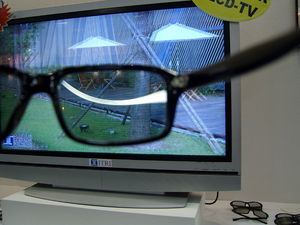Vizio showed off a new 3D TV at CES 2013. It uses technology that has been around for awhile, but only worked when viewing from the correct angle. The newest technology has multiple viewing angles, so there are fewer dead spots. Future displays are supposed to have many more viewing angles. So far, this is the closest anyone has come to creating true 3D television that does not require glasses, but Vizio won’t be releasing a real product until 2014 at the earliest.
Here are some of the key inventions and events that allowed 3D to come this far.
1838: Charles Wheatstone invented the 3D stereogram, along with a device called a Stereoscope. He found an explanation of binocular vision which led him to construct a stereoscope based on a combination of prisms and mirrors to allow a person to see 3D images from two 2D pictures.
1850: Wilhelm Rollmann developed the first method to produce anaglyph images, and glasses for viewing them. The method used two colors. Each image is made of two separate images in a different color, and the glasses allow each eye to see only one of the combined images. Red and cyan were the most common colors, as they produce less ghosting than other color combinations. Anaglyphic movies did not do well because the glasses can cause headaches.
1861: Oliver Wendell Holmes, Sr. invented an improved stereoscope that did not need mirrors. It was also much less expensive to produce, helping it to remain hugely popular for decades.
1890: William Friese-Greene received the first 3D movie patent. The patent explains that the film would be broadcast on two separate screens. A stereoscope would merge the two views into one, which appeared to be 3D to the viewer.
1896: Auguste Berthier discovered the principle of the parallax barrier. At the time, it had no practical use.
1901: Frederic E. Ives created the first functional autostereoscopic images. This is the first use of 3D without glasses, but was not feasible for movies until much later.
1934: Edwin H. Land invented Polaroid plastic sheet polarizers. For movies, two synchronized films are projected onto one screen with opposite polarizing filters. Glasses with the same polarizing filters are used to view the images from one projection for each eye, producing 3D images for the viewer.
1970s: Arch Gobler developed Space-Vision 3D. The new invention eliminated the need for dual-reel movies by overlaying two stereoscopic images on one reel. Unfortunately, there was a trade-off: the movies were not as clear as their 2D counterparts.
1970: A company called Stereovision invented a new way to project two reels of film through one Polaroid filter. The two reels were displayed side-by-side on one anamorphic film strip, producing a single 3D movie.
mid-1970s: Liquid crystal (LCD) shutter glasses were invented by Stephen McAllister, from Evans and Sutherland Computer Corporation. The glasses work by alternately turning black, obscuring the view for each eye in time with the frame rate of the TV or projector. This allows a single display to show a separate image for each eye, by quickly alternating the two images. The human brain sees it as a single, continuously flowing 3D movie.
2005: Philips created technology that uses a parallax barrier over the display. The barrier consists of slits that only allow vertical lines of pixels to show through from specific angles. This allows the viewer to see two images at once, as long as they are watching the display from the correct angle.






